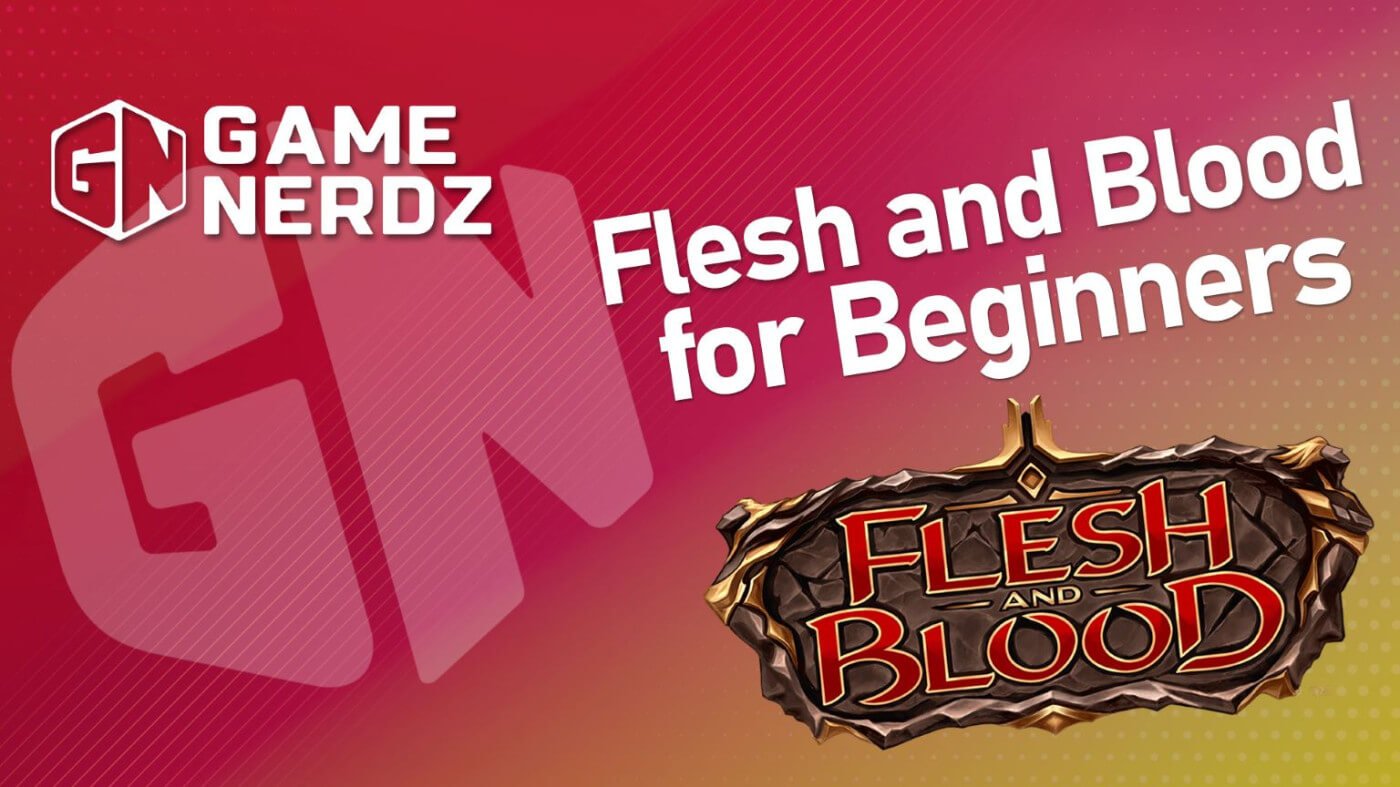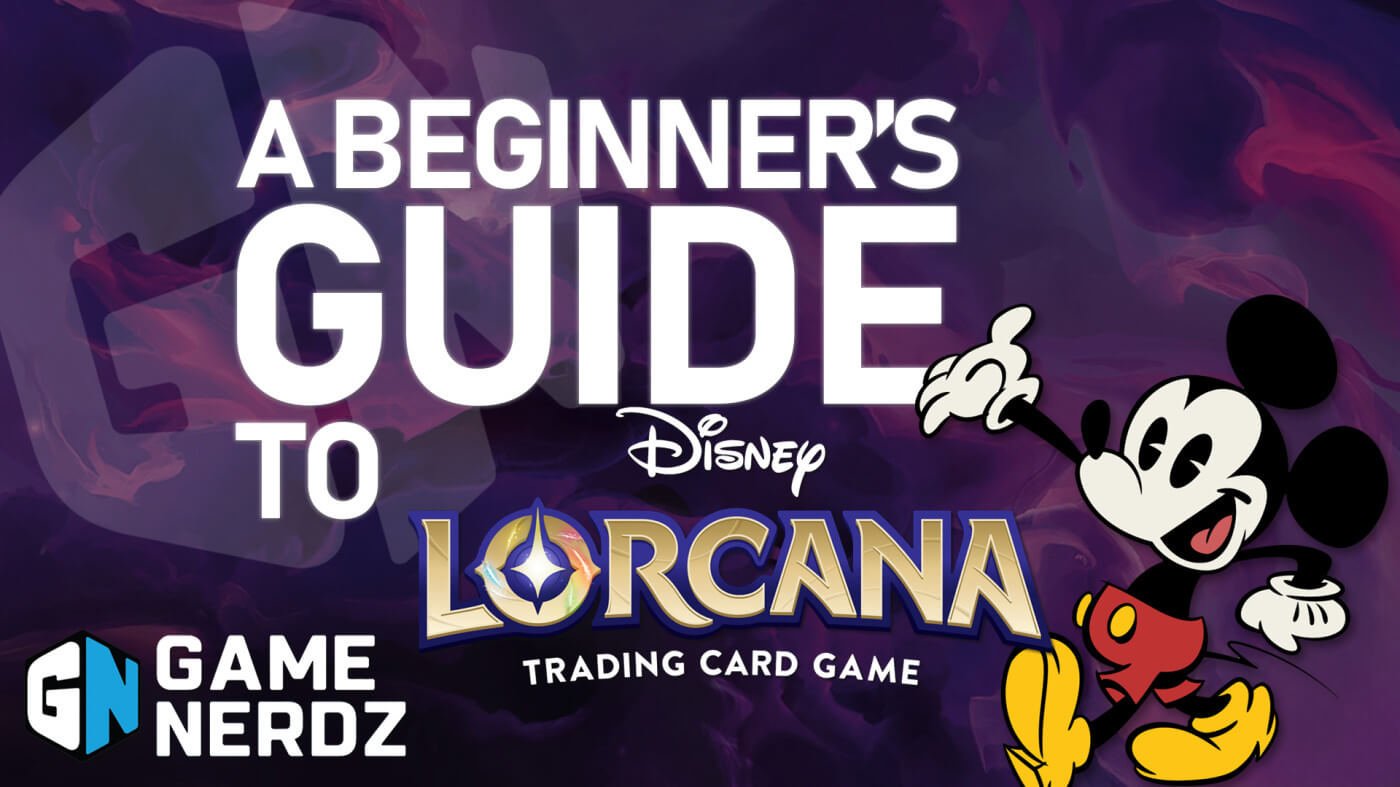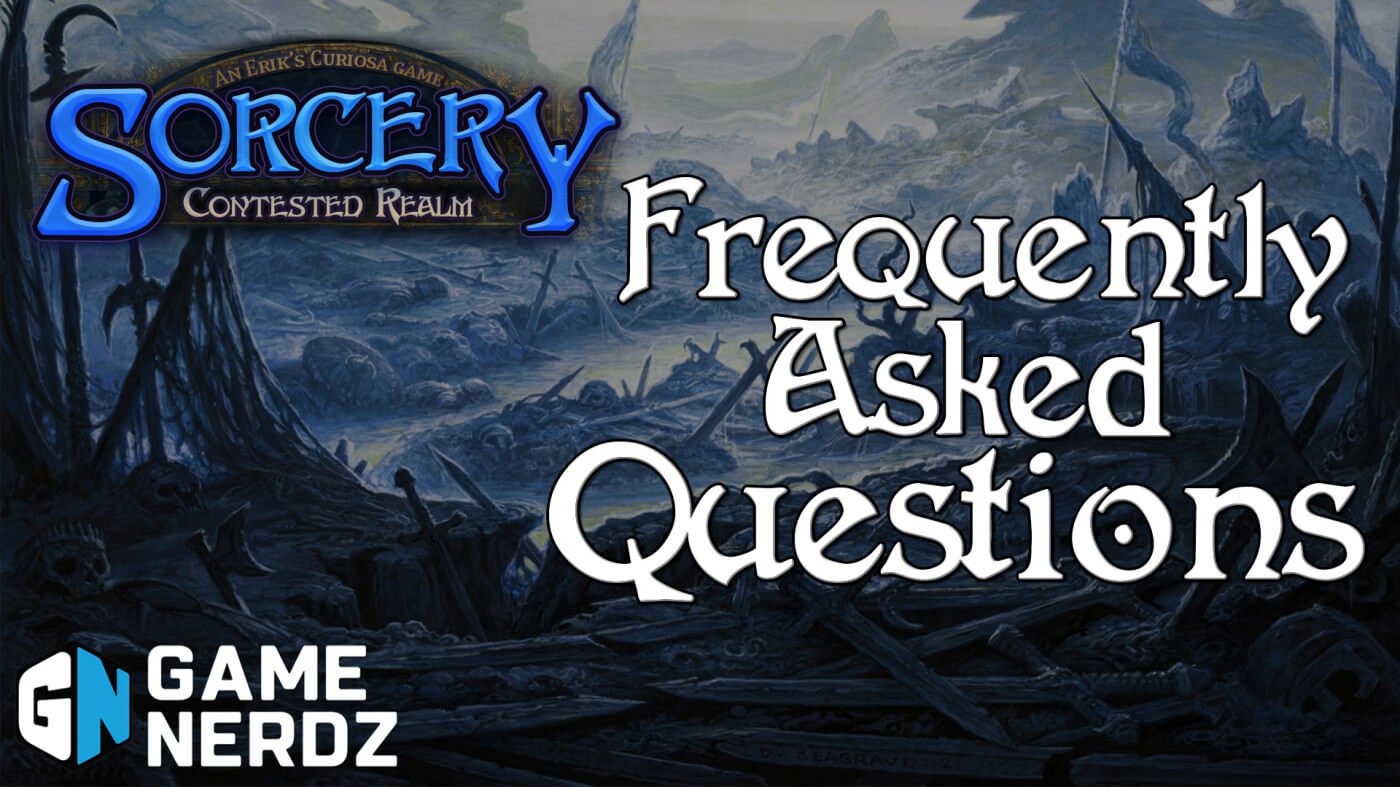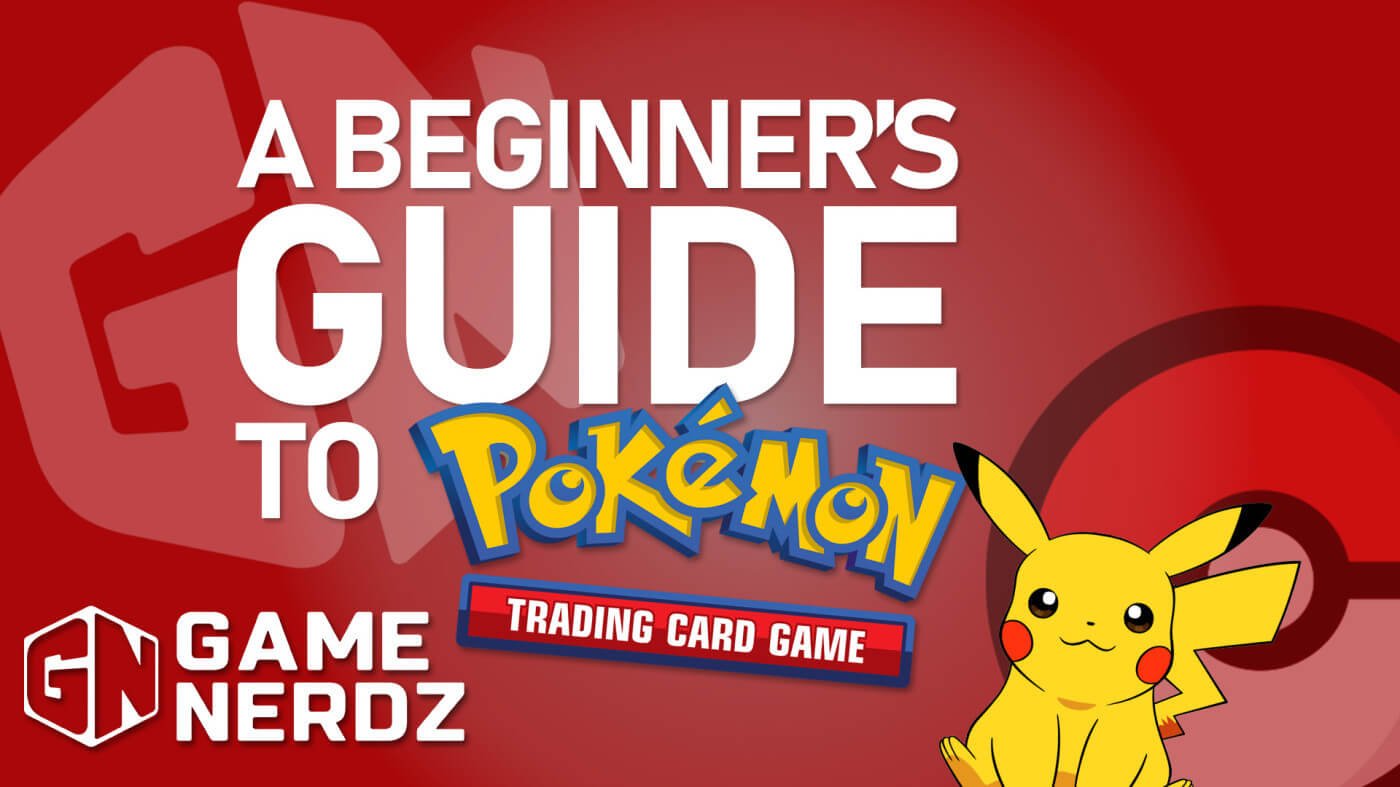
Beginner's Guide to the Pokemon Trading Card Game
Gotta Catch em’ All
The year is 1999 and somewhere surrounding the buzz of post-apocalyptic prophecies of Y2K are cute and collectible Pocket Monsters. Whether you were around for Y2K or not, you’d have to be living under a rock for the last 26 years to have never heard of Pokemon. It seems that everywhere you look, no matter where you go, there’s a Pikachu smiling back at you from someone's backpack or bumper sticker.
While it may be true that the 90s were a breeding ground for nostalgic trends, not everything from that era has managed to captivate the world the way that Pokemon has. So today, let’s pay homage to our adorable and fierce friends by learning the fundamentals of the Pokemon Trading Card Game.
To say the game mechanics are simple might be an understatement. It was developed with an age rating of just 6 years old, after all. That being said, we’ll take it slow in this blog and cover the basics necessary to get started.
Understanding Pokemon Card Types & Zones
Each player begins the game with a deck of 60 cards exactly, consisting of Pokemon, Trainer, and basic Energy cards. When constructing your deck, you are allowed up to four cards with the same name. Energy cards are the exception and you may have as many of the same type as you’d like.

In addition to Energy cards, which will serve as resources, there are two different kinds of cards that will make up your deck: Pokemon and Trainers. First, let’s become familiar with the structure of a Basic Pokemon card.
Basic Pokemon Cards

As shown in the top left corner, Magikarp is classified as Basic, which means this is the starting form of the Pokemon. Only Pokemon with the Basic title can be placed in the Active zone or Bench zone, so it is essential to have plenty of these when building your deck. The Active zone is where you will house the Pokemon that is going to battle the Pokemon in your opponent's Active zone. The Bench is where you will store up to five other Pokemon which you may swap in if your Active Pokemon is Knocked-out or if you pay the Retreat cost.
Pokemon HP
All Pokemon have HP (Hit Points) which can be found in the top right corner of the card. Magikarp has 30HP and once it has received damage equal to or in excess of this total, it will be Knocked-Out and placed in the players Discard pile along with any Energy or trainer cards attached to it. Don’t let the Discard pile worry you though, there are many cards that allow you to retrieve certain cards from the Discard pile and bring them back into the game.
Attacks
The attacks that a Pokemon is capable of performing are located in the center of the card. To the left of the attack name, you will find the energy cost required to perform it. For example, in order for Magikarp to perform Expert Splasher and hit its opponent for 10+ damage, it requires one water-type energy to be placed beneath it. Many attacks may require you to perform an action, such as flipping a coin, to determine if the attack hits or does extra damage depending.
Aside from main attacks, many Pokemon also have an Ability that can be triggered when the proper conditions are met.
Pokemon Types
Each Pokemon is associated with a certain Type which will act as its unique characteristic. These specific types also tie in the backstory, or lore, and bring the world of Pokemon to life. The different types of Pokemon are:
- Grass
- Fire
- Water
- Lightning
- Fighting
- Psychic
- Dark
- Metal
While each Pokemon should leverage its type in battle, they also need to be aware of its weaknesses.

Weakness & Resistance
In our example, Magikarp has a 2x Weakness to Lightning-type Pokemon which can be found on the lower left hand side of the card. This means that when Magikarp is dealt damage from a Lightning-type Pokemon, the total damage from the attack would be multiplied by two. Resistance, if Magikarp had one, would refer to the type of Pokemon that he takes less damage from. For example, if your Pokemon has -30 Resistance to a Fighting-type Pokemon, you would subtract 30 damage from the total of the incoming attack. The blue water drop symbol beside HP indicates that Magikarp is a Water-type Pokemon and will be especially strong against Pokemon with a weakness to that type, but do less damage to those with a resistance to its type.
Retreat
If your Active Pokemon has taken severe damage and you want to preserve it for later use, on your turn, you may Retreat it back to the Bench. To do this, you must pay the associated Energy cost which can be found in the lower right hand side of the card. Keep in mind that any damage or effects that your Pokemon has endured will remain present, even once it has retreated to the Bench.
Stage 1 Pokemon & Evolution
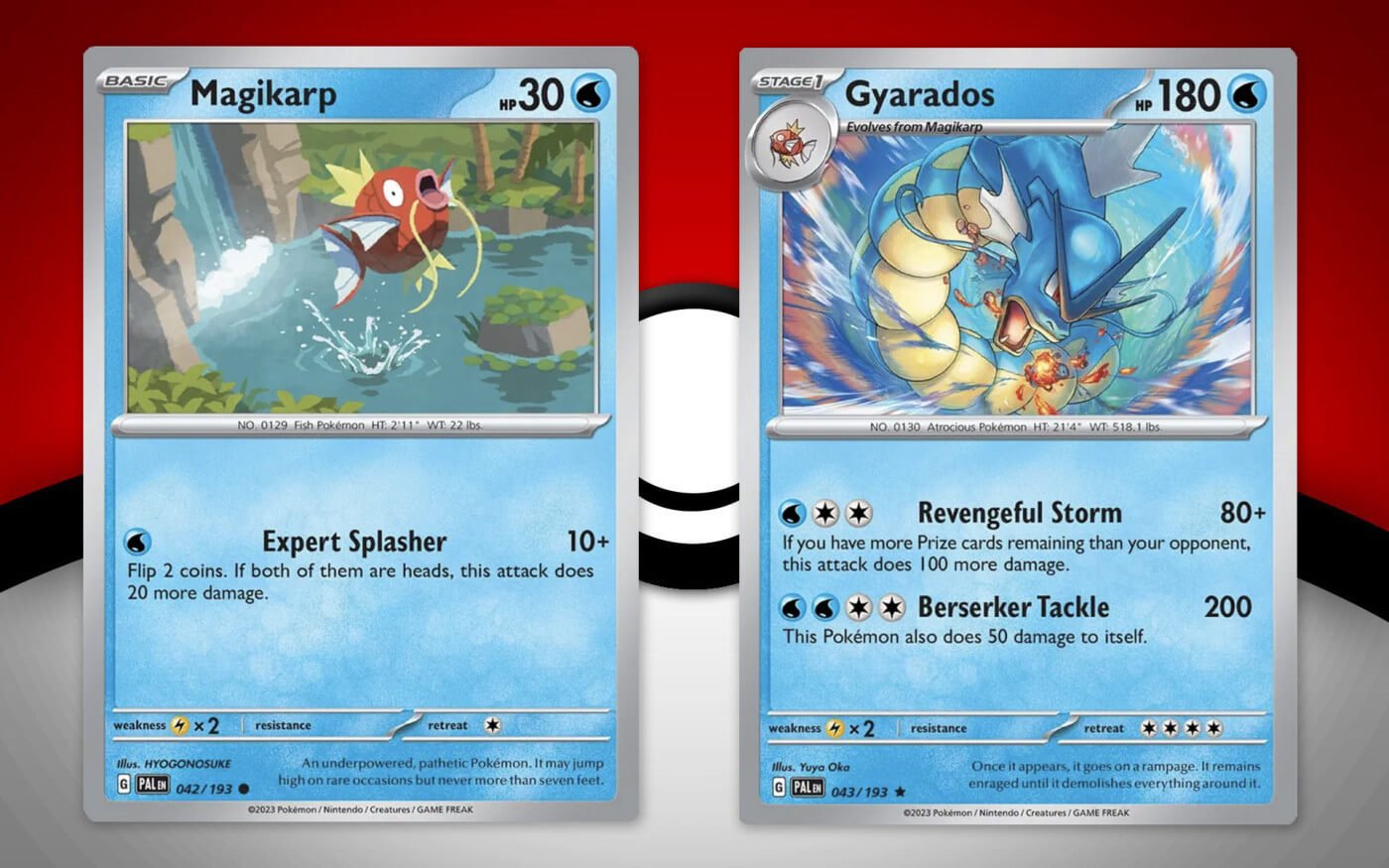
Now that we’ve covered how to read a Basic Pokemon card, let’s take a look at Stage 1 Pokemon. Gyarados is classified as a Stage 1 Pokemon because it’s the first stage in Magikarp’s evolution. This information will always be notated in the top left corner of the card and will even show a small picture of the Basic Pokemon it evolves from in the case that you need a visual reminder.
To evolve a Basic Pokemon, simply place the corresponding Stage 1 Pokemon on top of the Basic Pokemon. Any previous damage dealt to the Basic Pokemon will be transferred to Stage 1 Pokemon. Similarly, any attached Energy cards will be retained and carry over to the newly evolved Pokemon.
Trainer Cards
Now, let’s take a look at the different kinds of Trainer cards and explore some of their utility.

There are three different types of Trainer cards that supplement your play style and synergize your deck. Each one is beneficial in its own way and either requires certain conditions to be met or gives you instructions on what you can do when the card is played.
Supporter Trainer cards will often function as card manipulation and allow you to draw cards, replace cards, or search your deck or discard pile for certain cards.
Item Trainer cards are utilized to heal or remove negative conditions from your Pokemon. Some can even be attached to your Pokemon to give them added benefits while they’re in play.
Lastly, Stadium Trainer cards are played in the middle of the arena and affect both you and your opponent. Only one stadium card can be present on the field at a time, so if another one were to be played, the previous one would be discarded. Each Stadium card offers different effects, and since they affect both players, they should be carefully selected when building your deck.
Setting Up & Playing Pokemon
Once you and a friend have shuffled your 60-card decks, it's time to flip a coin to decide who goes first. After the coin flip has determined the starting player, each competitor will draw the top 7 cards of their deck. Because you must have a Basic Pokemon to begin the game, if you do not draw one, you may Mulligan. To do so, you must show your opponent your entire hand, proving that you didn’t draw a Basic Pokemon, and then shuffle all 7 cards back into your deck. Repeat this process until you have drawn at least one Basic Pokemon. Your opponent may choose to draw an extra card for each time you Mulligan, once again proving the benefits of having plenty of Basic Pokemon in your deck.
Establishing your Battlefield

Source: The Official Pokemon TCG Channel
Once you’ve drawn a 7-card hand with at least one Basic Pokemon, you will choose one pokemon to begin the game as “Active,” and place it face down into the Active zone. You may then place up to 5 other Basic Pokemon face down into your Bench. Lastly, take the top 6 cards of your deck and place them face down into the Prize zone without looking at them. Each time you knock-out an opponent's Pokemon, you will draw one of these Prize cards and add it to your hand.
Once you and your opponent have completed all of the steps above, each of you will reveal the face down cards in your Active and Bench zones. You're ready for battle!
Turn Structure
Each turn consists of three main parts: Draw, Actions, and Attack, in that order. Let’s break down each of these sections one by one.
Draw: At the start of your turn, even if you go first, you must draw a card. This ensures that each player is going through their deck at a proper pace and not stalling out the game. If at any point you cannot draw a card at the beginning of your turn, you lose the game.
Actions: There are many actions that can take place and do not require you to play them in any order or sequence. You may play a Basic Pokemon by putting it into your Bench zone, evolve a Pokemon, attach an energy card to a Pokemon, play a trainer card, retreat your Active Pokemon, and use your Pokemon’s abilities. You may do as many of these actions as you’re able to, though there are some limitations:
- You may not attack on your first turn
- You may not play a Supporter card on your first turn
- You may not evolve a Pokemon on your first turn
- You may not evolve a Pokemon that was played within the same turn
- You may not evolve the same Pokemon more than once per turn
- You may only attach one energy per turn (either to an Active or Benched Pokemon)
- You may only play one Supporter and one Stadium card per turn
- You may only Retreat one Pokemon per turn
Attack: Attacking will conclude your turn so be sure that you’ve carried out any actions before moving to this step. As we covered earlier, each Pokemon will have an Energy cost beside its attack and you must have the proper amount in order to successfully carry it out. Because many Pokemon have multiple attack options, you must announce the attack before calculating damage dealt. Remember to take into account any Weakness or Resistance before applying any damage counters to a Pokemon after the attack. Many attacks have additional text that will apply when the damage occurs, so be sure to follow any instructions attached to the attack chosen.
Special Conditions & Checkup
Many Pokemon extend further detrimental applications besides raw damage, which are called Special Conditions. Currently, there are five Special Conditions that can be applied to an affected Pokemon and can make a drastic difference in your strategy whether you are the aggressor or victim. Some Special Conditions require you to assess the situation of your Pokemon during Checkup, which occurs before the drawing portion of a turn. The five Special Conditions are:

Asleep: When an effect or attack puts your Pokemon to sleep, the card will be turned 90 degrees counterclockwise so that the top of the card is facing your Prize cards. While Asleep, your Pokemon cannot attack or retreat (unless a Trainer card or another ability allows them to). During Checkup, you will flip a coin. If heads, the Pokemon will wake up. If tails, it will remain Asleep until your next Checkup. Repeat this process until your Pokemon finally wakes up. Evolving the Asleep Pokemon will also wake it up, allowing you to turn it right side up.
Burned: When an effect or attack Burns your Pokemon, you will place a Burn Counter and two damage counters (10 damage each) on top of the card. You then immediately flip a coin. If heads, you will remove the Burn Counter. If tails, you will leave the Burn Counter on the Pokemon and repeat the coin flip process during the next Checkup. Before each coin flip, you must add 2 damage counters to indicate the Burn effect. Burns can also be removed by Trainer card effects, Evolving, or moving to the Bench.
Confused: When an effect or attack Confuses your Pokemon, the card is turned 180 degrees so that it is facing your opponent. Before attacking with a Confused Pokemon, you must flip a coin. If heads, the attack is successful. If tails, the Pokemon attacks and deals 30 damage to itself. Confusion can be removed by Trainer card effects, Evolving, or moving to the Bench.
Paralyzed: Some attacks will require you to flip a coin to determine if the targeted Pokemon will receive the Paralysis condition. If heads, apply one damage counter and turn the Pokemon 90 degrees clockwise so that the top is facing your Deck. Other stronger attacks will Paralyze a Pokemon without the need to flip a coin. Paralyzed Pokemon cannot attack or retreat, though they may be healed by Trainer cards or Evolution. After the player’s next turn, their Pokemon recover during Checkup.
Poisoned: When an effect or attack would cause your Pokemon to be Poisoned, you will place a Poison Counter and two damage counters (10 damage each) on top of the card. During Checkup, add one additional Poison Counter to the Pokemon and continue this process until your Pokemon is no longer Poisoned. Poison effects can be removed by Trainer card effects, Evolving, or moving to the Bench.
Some Special Conditions can stack, meaning a Pokemon can be Burned and Poisoned while Asleep, Confused, or Paralyzed. A Pokemon cannot be Asleep, Confused, and Paralyzed at the same time. If your Pokemon is already suffering from one of these Special Conditions, when a new one is applied, it will replace the previous one.
Knocking-out a Pokemon
When a Pokemon is Knocked-out, it’s placed into the discard pile along with any energy cards or items attached to it. If, for example, you’ve just dealt the final blow to one of your opponent’s Pokemon, you can expect to be rewarded with a Prize card. After you’ve claimed this victory, your turn is over and your opponent must now move a benched Pokemon into their active zone. If they’re unable to, you’ve won the game!
Winning the Game
After your three actions have taken place, your turn is over and now your opponent will take these same steps in their attempt to defeat your Pokemon. This back-and-forth continues until a winner is declared. Currently, there are three ways to win the game:
- Be the first player to take all of their prize cards
- Knock out all of your opponent's in-play Pokemon
- Your opponent runs out of cards in their deck and can no longer draw when prompted
Become the Very Best!
Pokemon has a plethora of introductory products that were created with new players, young and old, in mind and my recommendation is the Pokemon Battle Academy. This in-depth board game style experience will come complete with 3 decks, a playmat, damage and Special Condition counters, a coin, and multiple instructional guides to keep you learning at a steady pace.
Once you’re ready to challenge other worthy Trainers, I suggest you check out the official Pokemon Event Locator so you can plug yourself into your local community. Best of luck on your journey to become the very best like no one ever was!

